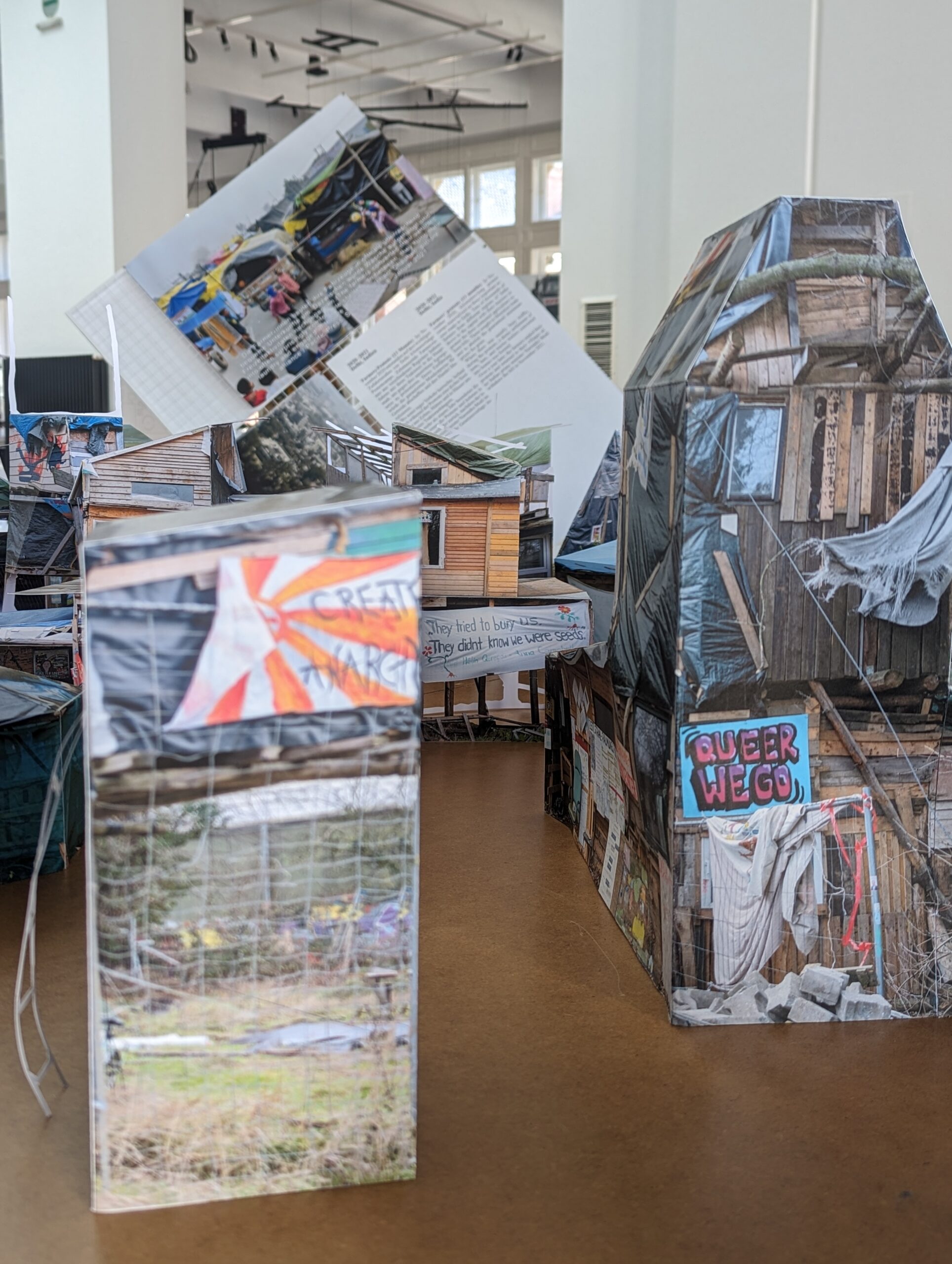The following is an exhibition review I wrote for the Burlington Art Writing Prize on PROTEST/ARCHITECTURE: Barricades, Camps, Superglue at MAK (Museum of Applied Arts), Vienna, Austria in the spring of 2024.
To begin, they barricaded the gallery. Three grated Czech hedgehogs balance alongside each other on the herringbone floor of MAK’s Upper Exhibition Gallery. Varying in heights and slants, each face of these structures’ wings are pinned with a largescale poster: on one, a photograph showing the early hours of Madrid’s 2011 anti-austerity protests on Puerto de Sol, where citizens established their hold of the square by swathing it in cardboard sheets; on another, an archival image of the wooden pylon watchtower at the center of the 1980 Republik Freies Wendland encampment in Gorleben, which blocked the proposed site of a nuclear waste dump.

Angled and overlayed, light and confounding, these gentle “display” barricades by design firm Something Fantastic summarize the approach of MAK’s 2024 exhibition, PROTEST/ARCHITECTURE: Barricades, Camps, Superglue. Curated by Oliver Elser and Sebastian Hackenschmidt, PROTEST/ARCHITECTURE seeks to archive the provisional, adaptable, and vernacular constructions that define spaces of protest by leveraging historical examples towards understanding today’s struggles. But what is a barricade when it is made to restage, and not to resist? When it draws the eye but does not shield the body?
Leaning in one direction towards protest’s provisional nature, MAK’s team use materials already in the Museum’s possession to realize Something Fantastic’s exhibition design— the curators go so far as to list outright the handful of materials they needed to purchase. Leaning towards the other, towards the total vision of the vitrine, Elser and Hackenschmidt commissioned high-res paper models of encampments extrapolated from drone footage, tapped director Oliver Hardt to produce a new montaged film, and restaged several structures in the gallery on loan from active movements. Recurringly, PROTEST/ARCHITECTURE in its design, content, and commission, materializes the tension between demonstrational and institutional paradigms, between the provisional necessity of the protest and the archival impulse of the museum.
Entering the gallery at the crux of its L-shape, visitors are met with this didactic text:
“What have we learned? Protest architecture…
Claims space; is utopian; is effective; is risky; is defensive; is domestic; is symbolic.”
Nearby, an encyclopedic array of supplies is neatly displayed on a low plinth: a poncho, some rope, duct tape, a flashlight and a water bottle, bolt cutters, a bicycle, a radio, a blue tent… surprisingly regimented and nonetheless overwhelming. The near immediate definition of what protest architecture is and isn’t in the early didactic offers the viewer a tether to cling to as they survey a room littered with the quotidian objects, ephemera, constructions, and images of resistance. Anticipating this need, the catalog for the exhibition is itself a glossary, alphabetizing the room’s material and conceptual contents, from “anti-” to Black Lives Matter to counterinsurgency. Elsewhere, another low plinth contrasts a mid-century Austrian police uniform with the militarized exoskeleton of a contemporary version. This route from bolt cutters to rubber bullets functions as the exhibition’s A to Z, introducing visitors immediately to a familiar narrative of foreclosure: this is how citizens rise up, and this is how the state prevails.
To meet the provisional with the archival impulse is perhaps to return to a bruise left by regimes of subjugation. On a small table between the barricades and the supply display, 40 paper structures by artist Rokas Wille recreate the Lützerath encampment, an anti-coal demonstration violently displaced by police at the end of 2023. When active, the Lützerath encampment was a dynamic environment of construction, repair, and care, with new structures emerging as new needs arose. Wille’s work freezes the encampment at its zenith, right before its demolition by state forces. Using handheld, drone, and satellite photography to restage these spaces on miniature scale, the exhibition’s models employ the same counter-insurgent technologies of vision to satisfy the archival eye. Perhaps, to archive the provisional with military-industrial assisted vision is to again press a fist into purpled flesh.

An ungenerous, pre-Sedgwickian “paranoid” reading would stop here—another curatorial team too enamored with form and archival aesthetics to see their own complicity in spatial and visional hegemonies. And yet, seeing protest architectures through the vectors that surveil them offer visitors two critical perspectives: the bird’s eye view and hindsight. How are these rebellious landscapes read by police forces and the private interests that back them? What recurrent forms and strategies must be re-evaluated and adapted to render them more effective? To see as the institution sees, an inflection on how a state might see is itself a tactical aesthetic choice on the part of the curators.
One of PROTEST/ARCHITECTURE’s most salient moments occurs in a far back corner, where the curators have displayed legal advice on Austrians’ right to assemble and demonstrate. This printed consult waits quietly to guide future demonstrators through the judicial system, written in plain language for clear and accessible public consumption. Both the institutional and state gaze are virtually unavoidable—but as PROTEST/ARCHITECUTRE maintains, knowing how this gaze is laid upon you is invaluable—and subvertable—knowledge.

MAK’s barricades will come down on August 25th— not by bulldozer or by cudgel, but by the professionalized hands of the museum’s install team, with parts of the exhibition potentially salvaged for future use. As students continue to establish and enliven encampments on college campuses across the globe, and as their reclamation of space in the name of justice continues to be met with violence, we might keep to the words of one Gorleben demonstrator featured in the exhibition:
“There’s this area and you build something there and it’s your only way of showing you want something different there, by showing what you want it to be. If you just think it’ll be torn down anyway and don’t build anything in the first place, nothing will ever happen. But maybe it won’t be torn down, you never know.”

